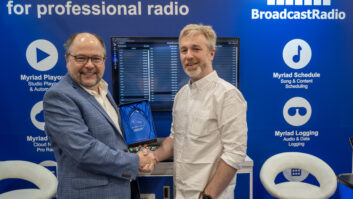
A Sherlock Holmes mystery is performed by the Red-Throated League of the Norwegian Explorers of Minnesota. The Pavek Museum of Broadcasting, in a suburb of Minneapolis/St. Paul, Minn., is a place anyone can enjoy. Visitors are greeted by a vintage 250-watt AM broadcast transmitter and studio console complete with microphone and turntables, as well as by Managing Director/Curator Steve Raymer.
There are 12,000 square feet of antique radios, televisions and broadcast transmitting equipment ready to be explored. The museum opened in 1988 with its namesake Joe Pavek Collection and grew to be a $400,000/year budget in this nonprofit organization with wireless audio and video tours for visitors.
The museum features a working spark gap transmitter in the “Titanic” section to show visitors what pre-voice communications were like in 1912.
One of the best displays is a Magnetophon tape recorder from the Jack Mullin Collection. This is the rarest of tape machines, German-made during World War II. Mullin brought two back to the United States after the war and modified them for production under the Ampex name. Bing Crosby was the first to recognize its potential and used them in his 1947–48 broadcast season, a significant first in the entertainment industry.

Steve Raymer, managing director of the Pavek, wears a Zenith long-distance radio shirt. Another display showcases an original de Forest Audion tube. It is generally agreed that Lee de Forest did not fully understand what he had in this tube. Edwin Armstrong was the one who figured out what was making the tube amplify radio signals, but de Forest received the credit. Later versions of the electron tube made broadcasting possible for everyone.
You can also try your hand at making music on an RCA Theremin. This instrument from 1918 is an audio oscillator controlled by the player’s hands, which vary audio frequency and volume when near, but not touching, two antennas. The Theremin makes a hauntingly beautiful sound.
If you are a ham, there is a complete working Collins amateur radio station from the 1950s and another from the 1960s. If you are not involved in the hobby, the Pavek conducts classes so you can become a licensed amateur radio operator.

An original NBC chime signals the beginning and end of a program. Two Cub Scouts are shown here, learning how to produce a live closed-circuit radio show. There is a lot to try and learn from in this museum, including military radios. It is hard to stay away whenever I am in town, and I visit about two to three times per year.
Kids 9 to 14 will like “Magnets to Megahertz.” It is described as a 14-week hands-on enrichment for the electronics wizards of tomorrow. The museum also offers an electromagnetism course, and oldsters like the radio workshop where vintage radio repair is taught.
Field trips from local schools and scouting groups make frequent appearances at the Pavek. A broadcast workshop has kids doing a live radio program on closed-circuit KPAV radio while being watched by parents and others through large windows. The audio console is believed to be Serial Number 1 of a Collins 212E1 audio console from 1959, purchased on the NAB floor by broadcaster Jim Wychor for use at KWOA in Worthington, Minn. There is a working vintage teletype system where news flashes are received in the studio and read live during the program.

Mark Persons is shown with a Type 23 Western Electric 250-watt AM transmitter from 1936 and a Gates model SA-40 “Speech Input Console” from the 1960s. A recent broadcast read: “A cow has jumped over the moon. The world’s first rocket-powered bovine space flight was successful. NASA announced today that is has plans to start lunar cheese production by the end of the year!” (You should see expressions on the faces of kids when this happens.)
Visitors are also treated to Sherlock Holmes at the museum once a year. This is where the “Red-Throated League of Norwegian Explorers” puts on a radio play, complete with commercials touting stomach remedies from the 1930s and ’40s as well as live sound effects.
Here you can also learn about the Minnesota Broadcasting Hall of Fame, which features 164 honorees and is growing. See stories about these broadcast icons and what they did for the industry.
Some 8,500 visitors experience this place each year, and many broadcast groups meet there, including local SBE Chapter 17, the Minnesota DX Club, the Audio Society of Minnesota and the Morse Telegraph Club. The Northland Antique Radio Club does part of their annual Radio Daze swap meet in the spring at the Pavek.

An original Magnetophon tape recorder from WWII Germany. It revolutionized audio and then television recording. The museum also runs a dubbing service to copy old film and video for a fee to CDs or hard drives.
The website,www.museumofbroadcasting.org, showcases a lot of history, including stories about pioneer broadcasters.
The museum would like to complete its collections with more Titanic-era Marconi equipment and a working (or reproduction) mechanical scanning disc television. Maybe you can help.
Mark Persons, WØMH, is a Certified Professional Broadcast Engineer and has more than 30 years’ experience. His website iswww.mwpersons.com.






